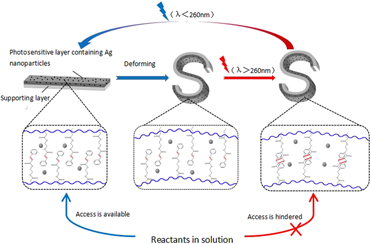Crossref Citations
This article has been cited by the following publications. This list is generated based on data provided by
Crossref.
Korde, Jay M.
and
Kandasubramanian, Balasubramanian
2020.
Naturally biomimicked smart shape memory hydrogels for biomedical functions.
Chemical Engineering Journal,
Vol. 379,
Issue. ,
p.
122430.
Delaey, Jasper
Dubruel, Peter
and
Van Vlierberghe, Sandra
2020.
Shape‐Memory Polymers for Biomedical Applications.
Advanced Functional Materials,
Vol. 30,
Issue. 44,
Chen, Yuewen
Dai, Shengping
Zhu, Hao
Hu, Hongwei
Yuan, Ningyi
and
Ding, Jianning
2021.
Self-healing hydrogel sensors with multiple shape memory properties for human motion monitoring.
New Journal of Chemistry,
Vol. 45,
Issue. 1,
p.
314.
Wan, Zhiqiang
Pu, Lei
Zhang, Yuan
Shen, Xiaojuan
Zhu, Maiyong
and
Li, Songjun
2022.
Polymer Catalyst with Photo-Mediated Catalytic Ability, by Virtue of Cis/Trans-Alterable Conformation.
Journal of Inorganic and Organometallic Polymers and Materials,
Vol. 32,
Issue. 6,
p.
2022.
Muzzio, Nicolas
Eduardo Martinez-Cartagena, Manuel
and
Romero, Gabriela
2022.
Soft nano and microstructures for the photomodulation of cellular signaling and behavior.
Advanced Drug Delivery Reviews,
Vol. 190,
Issue. ,
p.
114554.
Dadashi, Jaber
Ali Ghasemzadeh, Mohammad
Alipour, Sakineh
and
Zamani, Farzad
2022.
A review on catalytic reduction/degradation of organic pollution through silver-based hydrogels.
Arabian Journal of Chemistry,
Vol. 15,
Issue. 9,
p.
104023.
Costa, João B.
Silva-Correia, Joana
Reis, Rui L.
and
Oliveira, J. Miguel
2024.
Hydrogels for Tissue Engineering and Regenerative Medicine.
p.
293.
Valioglu, Ferzane
Valipour, Fereshteh
Atazadeh, Shadi
Hasansadeh, Maryam
Khosrowshahi, Nafiseh Didar
Nezamdoust, Fereshteh Vaziri
Mohammad-Jafarieh, Parisa
Rahbarghazi, Reza
and
Mahdipour, Mahdi
2024.
Recent advances in shape memory scaffolds and regenerative outcomes.
Biomedical Engineering Letters,
Vol. 14,
Issue. 6,
p.
1279.
Ghasemi, Soheila
and
Kafshboran, Hadieh Rahbar
2024.
Polyacrylamide Supported Reagents and Catalysts in Various Organic Reactions.
Catalysis Surveys from Asia,
Vol. 28,
Issue. 1,
p.
1.
Müller, Stefanie M.
Nelson, Benjamin R.
Höller, Rita
Waly, Christoph
Jelinek, Alexander
Kirkpatrick, Bruce E.
Keyser, Sean P.
Naderer, Christoph
Sivun, Dmitry
Jacak, Jaroslaw
Anseth, Kristi S.
Bowman, Christopher N.
Schlögl, Sandra
and
Griesser, Thomas
2025.
Chalcones as Wavelength-Selective Cross-Linkers: Multimaterial Additive Manufacturing of Macro- and Microscopic Soft Active Devices.
Chemistry of Materials,
Vol. 37,
Issue. 8,
p.
2699.


